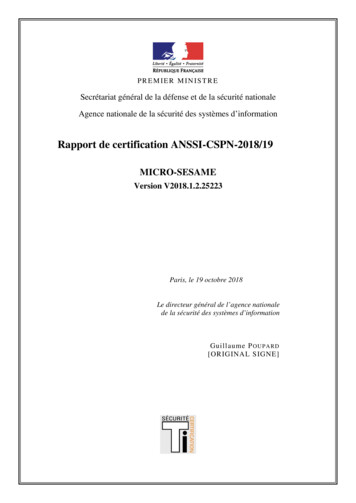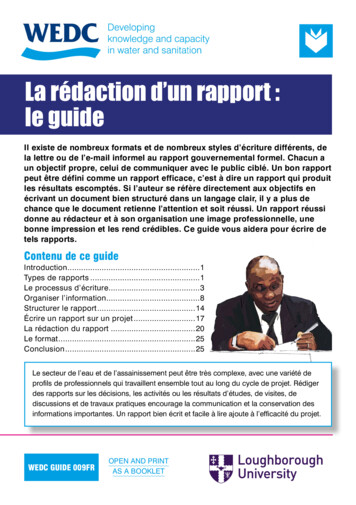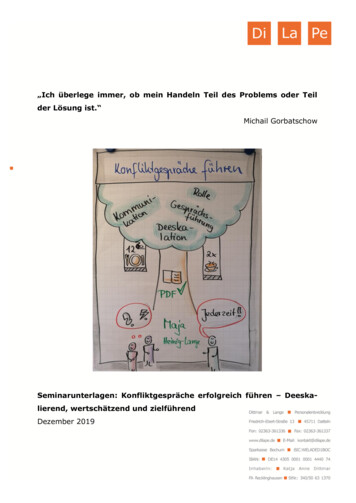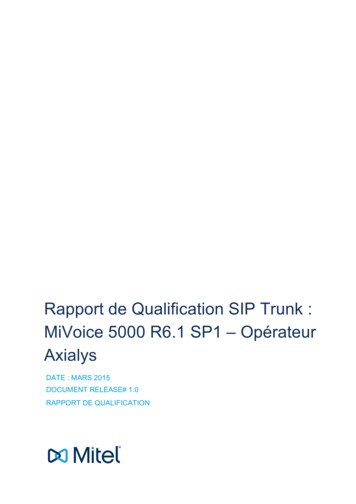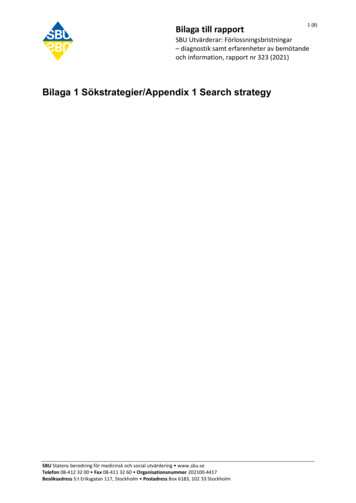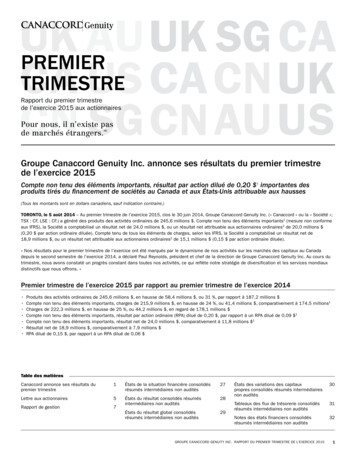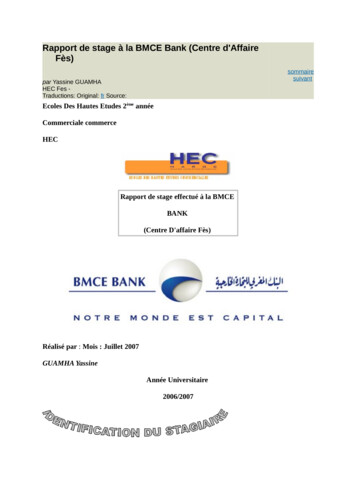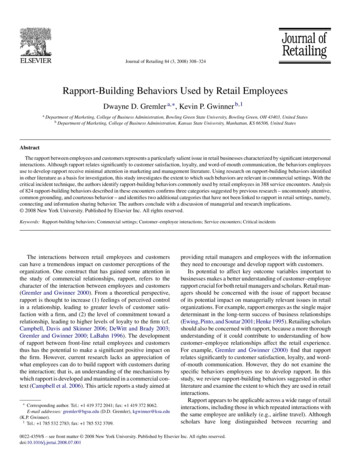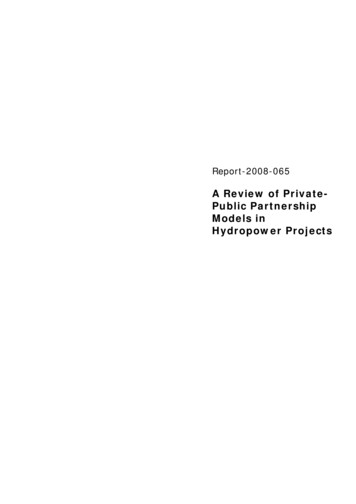
Transcription
Report-2008-065A Review of PrivatePublic PartnershipModels inHydropower Projects
Econ-Report no.2008-065, Project no.56390ISSN: 0803-5113, ISBN 82-7645-983-8RAN/abe, THP, 11. June 2008PublicA Review of PrivatePublic PartnershipModels inHydropower ProjectsCommissioned byNile Basin InitiativeEcon Pöyry ASP.O.Box 5, 0051 Oslo, Norway. Phone: 47 45 40 50 00, Fax: 47 22 42 00 40, http://www.econ.no
- Econ Pöyry - A Review of Private - Public Partnership Models in Hydropower Projects -
- Econ Pöyry - A Review of Private - Public Partnership Models in Hydropower Projects -Table of Contents:ABBREVIATIONS . 3EXECUTIVE SUMMARY . 11INTRODUCTION. 111.1 Objective and Methodology. 122FRAMEWORK . 132.1 NBI context. 132.2 Introduction to project finance. 152.3 Private-public partnerships models. 162.4 PPP Assessment Framework . 193INTERNATIONAL TRENDS . 234HYDROPOWER PPP MODELS: THREE CASE STUDIES . 354.1 Cana Brava, Brazil. 354.2 Birecik Hydropower Project, Turkey. 414.3 The Nam Theun 2 (NT2) Hydroelectric Project, Lao PDR. 475CONTEXTUAL ASSESSMENT. 595.1 Investment Attractiveness. 595.2 Power sector institutional set-up. 645.3 Power Sector Planning. 665.4 Water Resources and Multiple-Use Issues . 675.5 Regional Cooperation and Trade . 686APPLICATION AND ANALYSIS OF CONSOLIDATED LESSONSLEARNED . 716.1 Matrix of success factors . 726.2 Regulatory and legal setup. 736.3 Energy Sales Contracts . 746.4 Bidding process and award of concession . 766.5 Mobilizing investments. 786.6 Project Structure . 816.7 Project Implementation Arrangements . 836.8 Roles and responsibilities . 846.9 Risk allocation . 866.10Environmental and Social Impacts . 886.11Additional issues. 886.11.1 Planning horizon . 886.11.2 Expectations. 896.11.3 Enabling cross-border institutional arrangements . 897RECOMMENDED GUIDING PRINCIPLES TOWARDS A PPP MODELFRAMEWORK FOR NBI . 917.1 Riparian shared vision . 917.2 Guiding Principles . 92BIBLIOGRAPHY. 97ANNEX 1: PRIVATE PARTICIPATION IN ENERGY SECTOR, SUB-SAHARANAFRICA . 101
- Econ Pöyry - A Review of Private - Public Partnership Models in Hydropower Projects -
- Econ Pöyry - A Review of Private - Public Partnership Models in Hydropower Projects -AbbreviationsADBAsian Development BankAfDBAfrican Development BankBOT/BOOT/BOO/BOSS Build, Operate and Transfer/Build, Own, Operate andTransfer/Build, Operate, Own/Build, Operate, Sell and StartagainCODCommissioning Operation DateDBO/DBFO/DBFTDesign, Build, Operate/Design, Build, Finance and Operate/Design, Build, Finance and TransferDFIECAExport Credit AgencyENSAPEastern Nile Subsidiary Action ProgramEPCEngineering, Procurement and ConstructionESIAEnvironmental Social Impact AssessmentESMPEnvironmental Social Management PlanFCFinancial ClosureHPPIADBInter-American Development BankICBInternational Competitive BiddingIPPIndependent Private ProducersNBINile Basin CountriesNELSAPNile Equatorial Lakes Subsidiary Action ProgramMoUMemorandum of UnderstandingMDBMultilateral Development BankMDGMillennium Development GoalsMIGAMultilateral Investment Guarantee Agency
- Econ Pöyry - A Review of Private - Public Partnership Models in Hydropower Projects -PIPProject Implementation PlanPMUProject Management UnitPPAPower Purchase AgreementPPIPublic Private InfrastructurePPIAFPublic-Private Infrastructure Advisory FacilityPPPPrivate-Public PartnershipPTCPower Technical CommitteeRPTPRegional Power Trade ProjectSAPSubsidiary Action ProgrammesSSEAStrategic/Sectoral Social Environmental AssessmentSVPShared Vision ProgrammeWBWorld Bank
- Econ Pöyry - A Review of Private - Public Partnership Models in Hydropower Projects -Executive SummaryBackgroundThe investment needs in the power sectors of the NBI region are substantial, andhydropower will have to continue to make up a substantial part of the regionsgeneration mix if least cost principles are to be adhered to. As described in this paper,private-public partnerships (PPP) will likely have to emerge as a primary model forpower sector expansion if both public and private investment is to be mobilized andimplemented efficiently and effectively. Thus, the Regional Power Trade Project(RPTP) of the NBI has commissioned a review of the associated PPP financing andimplementation models, so as to draw out lessons learned that can inform a set ofguiding principles for its member states. Given the significant challenges andimplications of this work, as exemplified with both short- and long-term power crisesthroughout the region and the continent, the review and associated training workshopsrepresent an important component of the RPTP overall aim of establishing theinstitutional means to coordinate the development of regional power markets among theNile Basin countries.Objectives and MethodologyThe overall objective of the PPP Review is to;“arrive at a set of guiding principles, grounded in international lessons-learned, forNBI member countries looking to implement PPPs in the development and utilization oftheir hydropower resources.”In achieving this objective, two data collection and analysis streams have been carriedout. First, data and information from international databases, publicly availabledocuments and the institutional expertise housed at the consultant have been put to usein reviewing international trends and experience. The analysis of the three case studieshave been based on a detailed review of relevant documentation obtained from officialwebsites, the World Bank, donors and journals. Additionally, in providing arecommended PPP model framework, the consultant has carried out a review ofavailable literature on country-specific contextual issues for the NBI countries, as wellas reviewed the outcome of a questionnaire which was filled out by representatives ofmember states.International TrendsA review of international trends related to private-public participation in infrastructurereveals that shifting policy focus between public and private investment and ownership,respectively, had until recently left little space for innovative and pragmatic privatepublic partnerships. As a result, it appears that many countries, especially in Africa, willhave to play catch-up with respect to rapidly growing demand for infrastructureservices, particularly electricity. It is now well understood that in order to fill thegrowing infrastructure gap, public and private investors will be needed to carry out theirrespective comparative advantages. While the Asian financial crisis in 1997 and thecurrent global credit market turmoil present challenges, there remains strong interestand available funding in search of attractive power projects. This is particularly true forrenewable energy projects, given the rapid emergence of climate change concerns as aso-called mega-trend, having an impact on investment and policy trends.1
- Econ Pöyry - A Review of Private - Public Partnership Models in Hydropower Projects -Internationally, PPPs have been implemented in a wide range of industries and haveproven particularly useful in large-scale infrastructure projects in higher-risk countries.As indicated in later sections, PPPs can be viewed as an alternative to pure private andpure public implementation models, which provide a tool for mobilizing investmentwhile ensuring that the well-being of the public are looked after.The concept of private-public partnerships (PPPs) is a broad one, generally used todescribe financing, ownership and implementation models in which the government, theconsumer and the private developer share the risk of the project as well as the rewards.Specific PPP models are generally differentiated along a number of lines; modelemployed to select private partner; public and private ownership and financing shares;designation and distribution of specific endogenous (controllable) and exogenous risks;role of multi- or bi-lateral donor financiers; cross-border relations, and; time-frame. Thespecific PPP model which is most appropriate for a given project will be dependent on anumber of factors, including; the anticipated external benefits (e.g. beyond financialbenefits and costs of a project); the comparative operational advantage and relativefinancial strength of the public and private actors; and the planning horizons of thepublic and private actors. Broadly speaking, policy makers should choose a modelwhich best balances the need to mobilize private finance to a prioritized project with theobjective of maximizing the positive impact of the projects on the citizens andconsumers they represent.Case Studies and Lessons LearnedThe three case studies analyzed were Cana Brava, Brazil; Birecik, Turkey and NamTheun 2 in Lao PDR.Brazil prepared an Expansion Plan for 1997 to 2006 in which it was concluded thatmassive investments in generation capacity was needed to meet the growing demand.Therefore Electrobras 1 (Contrails Elétricas Brasileiras SA) proposed the construction ofthe Cana Brava run-of-river hydropower plant (450MW). The project was one of thefirst projects with private participation after the new institutional and regulatoryframeworks were established in 1995 and 1996 and it is one of the first IPPs to befinanced under a project finance mechanism in Brazil.In Turkey, Birecik is part of a 32 billion South Eastern Anatolia Project (known asGAP after its Turkish name, Guneydogu Anadolu Projesi). GAP has been largelyfinanced by the Government of Turkey, with 3.79 billion coming from foreign sources.Turkey's macro-economic troubles during the 1990s, however, led to an increasingreliance on external financing, including export credits from Germany, Switzerland,Italy, Austria and the USA. GAP consists of a planned network of 22 dams, 19 powerplants and ancillary irrigation and industrial projects, and GAP is intended to use thewaters of the Tigris and Euphrates Rivers to transform the Southeast of Turkey into aregional "breadbasket". The Birecik Hydropower Project includes a reservoir and672MW in installed capacity, and is expected to generate 2.5 billion kWh per year. Theproject was the first project, in any sector, using the build-operate-transfer (BOT)model. As the project was completed on time and under budget, it has be argued that theproject can be used as a role model in terms of the efficiency of having private1The major Utility in Brazil, the Government owns 52% of the stocks.2
- Econ Pöyry - A Review of Private - Public Partnership Models in Hydropower Projects -companies being in charge of the planning, financing, construction and operation ofhydro power plants.In Laos, the Government of Lao (GOL) signed a MoU in 1993 with the ThaiGovernment (GOT) in which GOL agreed to supply GOT with 1500MW of hydrobased power by 2000, an agreement that was later extended to 3000MW by 2006. GOLalso signed a MoU with Vietnam in 1995 to supply 1500 MW by the end of 2010 and in1996 a MoU was signed with Cambodia but no specific agreements in terms of MWsupplied were detailed. The Nan Theun 2 (NT2) is a large project (1075 MW) and theoverall purpose with the project is to “generate revenue through environmentally andsocially sustainable development of NT2’s hydropower potential to finance povertyreduction and environmental management programs in Lao PDR.”(World Bank, 2007)Table A provides a summary of the success criteria, as applied to the case studies.The analysis of lessons learned in the review focuses on the tools and approachesavailable to policy makers in pursuing the above stated objective; ie balancing the needto mobilize private finance while maximizing the developmental impact of the resultingproject(s). This analysis, together with the contextual assessment, is the building blocksof the proposed guiding principles, summarized below.3
- Econ Pöyry - A Review of Private - Public Partnership Models in Hydropower Projects -Table A.Summary of lessons learned versus success factorsSuccess factorBrazilTurkeyLao PDRTerms of the PPA forpublic entities,particularly the tarifflevel achieved by thesingle buyer.Not applicable – asPPA signed withprivate entityThe public utility took onthe majority of the riskswhich might have beennecessary to get thenecessary private fundingfor the project.Lao only kept 5% of the power of thisproject, but gained export revenue due tothe agreement with Thailand, who is asteadily growing economy withincreasing demand for electricityThe timeliness ofimplementation.Short and smooth,four years fromConcession award toCOD.Long and complex untilFC but short constructiontime.Long due to environmental and socialimpacts and external factors such as theAsian crisis which disturbed the MoUwith EGAT.The overall effect oncountry/region’s powersector.Cana Brava was partof a generationexpansion plan for1997-2006 and assuch it was aprioritized project.Part of a large scaleproject, the GAP, which isa highly prioritizedproject by the Turkishgovernment.Power mainly for export hence the projectwill mainly contribute to the countrythrough export revenues. NT2 is part of alarger program of economic developmentfor Lao citizen and hence the exportrevenues is geared towards thisprogrammeThe effectiveness andefficiency of operationand maintenanceNo negativereferences found, itseems that the plant isdelivering theexpected amount ofpower to the Braziliannet.No negative referencesfound, it seems the plantis delivering the expectedamount of power; onlyproblems relate toenvironmental and socialimpacts.N/A since its not yet in operationEfficiency andprudence of theprocurement process.Smooth ICB processComplex due tointerpretation ofconcession terminologyby DanistayDirect negotiationsBoth positive andnegative environmentaland social impactsSome negativeenvironmentalimpacts and somecomplaints regardinginadequateresettlementcompensationLarge social impacts, bothin terms of resettlementand in cultural values.Inadequate resettlementprocessesInitial delays due to inadequate ESIA butthe concession agreement now regulatesall social issues in detail and severalexternal independent audit teams arereviewing the work, approx two teamsper month.Impacts on crossborder relations.N/AWorld Bank did notsupport the project since itargued that ripariancountries did not approveit, could be a potentialconflict in the area.The Mekong River Commission wasestablished already in 1995 to assure themanagement of the water resources in theMekong river system, of which riverTheun is a part. Unlike the Birecikproject, the World Bank did support thisproject which means the project fulfilledtheir policy regarding internationalwaters.The overallsustainability of thePPP and PPA.SustainableThe transparency andgood governance could bequestioned due to the lackof international observers,such as Multilaterals.Good transparency and governance whichcan be partly attributed to the heavyinvolvement of multilateral agencies suchas ADB and WB as well as strong NGOs.Contextual ReviewThe contextual review sets out to identify key similarities and differences between theNBI member states (as a group) and the case study countries – as applicable inidentifying guiding principles based on lessons learned. A range of issues areconsidered, including; investment attractiveness; sector institutional set-ups; powersector planning; water rights and multiple use issues; and regional cooperation. Thecontextual assessment reveals that while there is a relatively wide range of institutional4
- Econ Pöyry - A Review of Private - Public Partnership Models in Hydropower Projects -preparedness for PPP throughout the region, overall there appears to be no reason tobelieve that the (relative) successes of the case study countries cannot be repeated, insome form, in the Nile Basin region.Guiding Principles for PPP Financing and Implementation ModelsBased on the international trends, lessons learned and contextual assessment, as well asdiscussions during the training workshop, a set of guiding principles has beendeveloped. These guiding principles are meant to serve as guide posts for the membercountries and NBI-RPTP in developing and implementing PPP models which will havea high probability of success. The key recommendations associated with theseprinciples are summarized below and laid out in detail in Section 7.2:1. Independent regulator should be in place before implementation of PPPs, as it iscritical for ensuring;a) transparent and fair processes – especially in case of (part)public ownership,b) that benefits of PPP reach the general publicc) the long-term sustainability of the project2. Progress is needed in much of the region in ensuring financial viability of the offtaker – before private capital can be raised on reasonable terms3. PPPs in hydropower are not a ‘quick fix’ and must be carefully planned anddiligently prepared, and should follow least-cost expansion principles. For manycountries in the region this will require a return to systematic investment planning.There is a risk that this will be neglected in favor of emergency power needs.4. Regulatory frameworks should allow for private financing (not necessarilyownership) of transmission lines which allow for evacuation of power – thusreducing the associated risk5. Public ownership of the ’reservoir component’ of HPPs could be particularlybeneficial in the region, given the likely multiple use benefit and the regionalimportance of the Nile River.6. Progress should be made towards improving power trade capabilities, and aRegional Hydropower Investment Help Desk should be considered for privateparticipation within the Nile Basin– as opposed to country-specific help desks.This could also serve as a platform for sharing of regional experiences and bestpractices in implementation of PPPs.5
- Econ Pöyry - A Review of Private - Public Partnership Models in Hydropower Projects -RésuméContexteLes besoins d’investissement dans les secteurs de l’énergie de l’Initiative du Bassin duNil (NBI: Nile Bassin Initiative) sont substantiels, et l’énergie hydroélectrique devracontinuer de représenter une part significative de la production afin d’en minimiser lecoût total. Tel que présenté dans ce document, les partenariats public-privé (PPP)deviendront très certainement le modèle principal de développement du secteur del’énergie afin de pouvoir mobiliser des financements tant publics que privés et d’assurerune gestion efficace et effective des investissements. Dans le cadre de son RegionalPower Trade Project (RPTP), le NBI a lancé une étude des modèles de PPP liés aufinancement et au développement de tels projets, afin de tirer les enseignements desexpériences en cours et d’établir un ensemble de principes directeurs pour ses EtatsMembres. Ainsi que l’ont démontré les crises énergétiques de court- et de long-termedans la région et sur le continent, ce travail revêt une importance majeure. L’étude et lesateliers de formation qui y sont associés sont un élément important de la stratégied’ensemble du RPTP visant à créer les moyens institutionnels pour coordonner ledéveloppement des marchés énergétiques régionaux parmi les pays du Bassin du Nil.Objectifs et méthodologieL’étude PPP a pour objectif principal :“d’élaborer, sur la base des enseignements d’expériences internationales, un ensemblede principes directeurs à l’attention des pays membres du NBI afin de faciliter la miseen oeuvre de PPP en vue du développement et de l’utilisation des ressourceshydroélectriques.”Afin d’atteindre cet objectif, deux types de collecte de données et d’analyse ont étémenées. Premièrement, les expériences et tendances internationales ont été examinées àpartir d’informations disponibles dans les bases de données internationales, ainsi quesur la base de l’expertise institutionnelle du consultant. Trois études de cas ont étéanalysées à partir de la documentation de sites internet officiels, de celui de la BanqueMondiale, des pays “donneurs” et des journaux de référence. Deuxièmement, le modèlede PPP recommandé par le consultant a été élaboré au moyen d’une revue de lalittérature disponible sur chaque pays du NBI, ainsi que sur la base des réponses à unquestionnaire adressé aux représentants des Etats Membres.Tendances internationalesL’analyse des tendances internationales relatives aux collaborations public-privé enmatière d’infrastructure montre que les changements d’approche entre investissement etpropriété public/privé au cours du temps ont jusqu’à présent laissé peu de place à lamise en oeuvre de PPP innovants et pragmatiques. En conséquence, beaucoup de pays,notamment en Afrique, devront faire face à une croissance rapide de leurs besoins eninfrastructure, notamment électrique. Il est désormais bien établi qu’afin de répondre àcette demande, il conviendra de mobiliser des investisseurs publics et privés et d’utiliserau mieux leurs avantages comparatifs. Même si l’expérience de la crise financièreasiatique de 1997 et les perturbations actuelles du marché du crédit mondial présententdes défis, il y a toujours un intérêt fort et de nombreuses possibilités de financementdisponibles pour développer de nouveaux projets énergétiques attrayants. Cela vautparticulièrement pour les projets ayant trait aux énergies renouvelables, étant donné6
- Econ Pöyry - A Review of Private - Public Partnership Models in Hydropower Projects -l’importance des préoccupations liées au changement climatique et leurs impacts sur lespolitiques énergétiques et sur les décisions d’investissement.Au niveau mondial, les PPP ont été mis en oeuvre dans un grand nombre d’industries etse sont révélés particulièrement utiles dans les projets d’infrastructure à grande échellemenés dans les pays « à haut risque ». Les dernières parties de l’étude soulignent que lesPPPs peuvent être une alternative crédible à des modèles de mise en oeuvre uniquementpublique ou privée. La valeur des PPP réside dans leur capacité à mobiliser des sourcesd’investissement tout en tenant compte des préoccupations d’intérêt général.Le concept de PPP est vaste et souvent utilisé pour décrire des modèles de financement,de propriété et de mise en oeuvre dans lesquels les autorités publiques, le consommateuret l’entrepreneur privé partagent le risque du projet, ainsi que ses bénéfices. Différentsmodèles de PPP existent selon la configuration du projet: modèle pour sélectionner lepartenaire privé; propriété publique et privée et montage financier; identification etpartage des risques endogènes (contrôlables) et exogènes; rôle des donneurs financiersmulti- et bilatéraux; relations transfrontalières; et calendrier d’exécution. Le modèle dePPP le plus pertinent pour un projet particulier dépendra de plusieurs facteurs,notamment: les gains externes anticipés (e.g. au-delà des gains et coûts financiers duprojet); l’avantage comparatif d’un point de vue opérationnel; le poids financier relatifdes acteurs publics et privés; l’horizon temporelle de ces mêmes acteurs en termes deplanification. En principe, l’objectif des décideurs publics devrait être de choisir unmodèle qui puisse combiner au mieux le besoin de mobiliser des financements privéspour un projet prioritaire avec l’objectif de maximiser l’impact positif de ce projet surles citoyens et les consommateurs qu’ils représentent.Etudes de cas et principaux enseignementsLes trois études de cas retenues sont Cana Brava au Brésil, Birecik en Turquie et NamTheun au Laos.Le Brésil a développé un Plan d’Expansion de 1997 à 2006. Ce plan souligne le besoinmassif d’investissement dans les capacités de production afin de faire face à lacroissance de la demande. Electrobras 2 (Contrails Elétricas Brasileiras SA) a proposé laconstruction d’une usine hydroélectrique “au fil de l’eau” (sans barrage) de 450MW surle Cana Brava. Le projet a été un des premiers projets à participation privée depuis queles nouvelles dispositions institutionnelles et réglementaires ont été adoptées en 1995 et1996. Il s’agit également d’un des premiers projets de PPP institutionnels à bénéficierd’un mécanisme de financement de projets au Brésil.En Turquie, l’usine Birecik fait partie du projet “Anatolie du Sud-Est” d’une valeur de32 milliards (connu sous l’appellation GAP, Guneydogu Anadolu Projesi). GAP étaitinitialement largement financé par le gouvernement turc, avec seulement 3,79 milliards en provenance de sources étrangères. Les difficultés macroéconomiques de la Turquieau cours des années 1990 l’ont cependant progressivement conduite à s’appuyer de plusen plus sur le financement extérieur, y compris sous la forme de crédits d’exportation enprovenance de l’Allemagne, la Suisse, l’Italie, l’Autriche et les Etats-Unis. GAPconsiste en la création d’un réseau de 22 barrages, 19 usines électriques et des projetsannexes d’irrigation et de développement industriel. GAP a pour but d’utiliser les eaux2La principale enterprise de travaux publics dans le secteur de l’énergie au Brésil, dont 52% du capital appartientau gouvernement.7
- Econ Pöyry - A Review of Private - Public Partnership Models in Hydropower Projects -du Tigre et de l’Euphrate afin de transformer le sud-est de la Turquie en une “corned’abondance” régionale. Le projet hydroélectrique de Birecik prévoit la création d’unréservoir et d’une capacité d’installation de 672 MW, en vue de produire 2,5 milliardskWh par an. Le projet a été le premier du genre, dans tous les secteurs, à être bâti selonle modèle « construction - gestion - transfert » (build-operate-transfer). Le projet a étéréalisé dans les délais et à un coût moindre que prévu : il est donc souvent cité commeun modèle d’efficacité en termes d’implication de sociétés privées dans la planification,le financement, la construction et la gestion d’usines hydroélectriques.Au Laos, le Gouvernment (GOL) a signé un accord de principe avec le Gouvernmentthaïlandais (GOT) en 1993 qui prévoit que GOL fournira à GOT 1500 MWd’hydroélectricité d’ici 2000. L’accord a été ensuite étendu à 3000 MW d’ici 2006.GDL a également signé un accord de principe avec le Vietnam en 1995 afin de fournir1500 MW d’ici la fin de 2010, ainsi qu’un accord avec le Cambodge en 1996, sanstoutefois spécifier un montant de livraison. Le Nan Theun 2 (NT2) est un grand projet(1075 MW) dont le but est de “créer un bénéfice durable du point de vueenvironnemental et social grâce à l’exploitation du potentiel hydroélectrique du NT2 envue de financer les programmes de réduction de la pauvreté et de gestion del’environnement au Laos” (Banque Mondiale, 2007).Le Table A ci-dessous fournit une synthèse des conditions de succès identifiés dans lesétudes de cas ci-dessus.L’analyse des enseignements se concentre sur l’approche et sur les instruments à ladisposition des décideurs publics pour atteindre l’objectif pré-cité: combiner le besoinde mobiliser des financements privés avec l’objectif de maximiser l’impact positif duprojet en termes de développement économique, social et environnemental. Les résultatsde l’étude ainsi que l’analyse de contexte ont permis de construire les principesdire
Public Partnership Models in Hydropower Projects . Econ-Report no.2008-065, Project no.56390 Public ISSN: 0803-5113, ISBN 82-7645-983-8 RAN/abe, THP, 11. June 2008 A Review of Private-Public Partnership Models in Hydropower Projects Commissioned by Nile Basin Initiative Econ Pöyry AS
